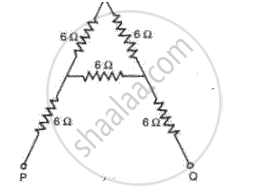Advertisements
Advertisements
प्रश्न
60 joules of heat was dissipated in a resistor when 20 C flowed for 5 s. Calculate:
(a) P.d. across the resistor,
(b) Resistance of the resistor, and
(c) Average power dissipated in the resistor.
उत्तर
Given, heat dissipated= 60 joules, charge Q = 20 C, time t= 5s
(a) P.d. across the rsistor, V = `"W"/"Q"= 60/20 = 3 "V"`
(b) Power = `"W"/"t" = "V"^2/"R"`
R = `"V"^2 xx "t"/"W" = (3)^2 xx 5/60 = 0.75 Omega`
(c) Power dissipated, P = `"W"/"t" = 60/5 = 12 "watt"`
APPEARS IN
संबंधित प्रश्न
Why should the resistance of:
an ammeter be very small?
Which instrument is used to measure electric current? How should it be connected in a circuit?
The p.d. across a 3 Ω resistor is 6 V. The current flowing in the resistor will be:
(a) `1/2A`
(b) 1 A
(c) 2 A
(d) 6 A
Two resistors of 2.0 Ω and 3.0 Ω are connected (a) in series (b) in parallel, with a battery of 6.0 V and negligible internal resistance. For each case draw a circuit diagram and calculate the current through the battery.
Distinguish between an open and a closed circuit.
Tick(✓) the correct choice in the following:
The outer casing of an electric iron is generally connected to earth in order
to
Find the effective resistance in the following circuit diagrams (Fig.):

What should I choose ___________________
b. for getting protection from electric current.
c. to measure the current in the circuit?
Name any two devices, which are working on the heating effect of the electric current.
